Relationship Between Multi-Teaching Styles and Didactics Effectiveness on Rugby Instructors and Minirugby Players
Abstract
1. Introduction
Aims
2. Materials and Methods
2.1. Sample
2.2. Instructors’ Background
2.3. Protocol
2.4. Measures
2.4.1. Instructor’s Group
- The Teaching Styles Questionnaire (TSQ; [44,45]) is designed to examine teachers’ teaching style methods, and it has been used to evaluate sports instructors [24]. The TSQ is based on the spectrum of teaching styles classified by [55]. The questionnaire presents for each teaching style a five-point Likert scale score. Points near to 5 express a frequent use of the teaching styles, while points near to 1 mean that it is not used.
- The Internship Evaluation Sheet in Physical Education and Sports (IESPES; [40,42]) is a tool designed to evaluate the instructors’ didactic competence. A score from zero to five points was attributed to communication capacity (verbal communication, voice, paralanguage, non-verbal communication), didactics organization (specific didactics, elements of organizational references), and capacity to motivate and to engage the pupils (psychological references, personal competence).
- The Empathy Scale for Teachers [48] is a self-evaluation questionnaire developed to measure educators’ empathy capacity in educational contexts. The questionnaire is composed of 19 questions with answers on a four-point Likert scale. The questionnaire reports an empathy final total score and three sub-scores related to cognitive, positive affective, and negative affective empathy.
- The Self-Control Questionnaire [49] is an evaluation tool for the measure of self-control. It is composed of items rated on a five-point scale, starting from 1 (“not at all like me”) to 5, (“very much like me”). The questionnaire, composed of 36 items, reports a final self-control total score and eight subscale scores (impulse control, goal setting, distraction control, self-monitoring, task initiation, emotion regulation, automaticity, and decision-making).
- Video analysis IFITS [47] and SOFIT [46]. Two lessons at the beginning of the sport season were video recorded, and the IFITS and SOFIT analysis systems were used to verify the instructors’ teaching styles, the children’s levels of physical commitment during the lessons, and the interaction capacity of instructors with them. The IFITS instrument gives the % of time spent on each instructor’s teaching style. The SOFIT instrument gives the % of time spent in sedentary behaviors (lay, sit, stand) or moderate to vigorous physical activity (walk or vigorous activity), the % of time spent for each lesson content (skills, game, fitness, management, knowledge, or other contents) and the % of time spent by the instructor in motivating children to activity (motivation focused on the inside lesson topic or outside lesson topic or not motivating).
2.4.2. Children’s Group
- Körperkoordinationtest für Kinder (KTK, [50]) is a coordinative test for children from 8 to 14 years old. It includes four tests (walking back, jumping sideways, moving sideways, and hopping for height). The result of each test is normalized, converted, and summed into a total motor quotient score (MQ) using a dedicated nomogram. The MQ indicates the children’s level of body mastery that can be allocated into six ranges: disturbed (MQ = 50–70), noticeable (MQ = 71–85), average (MQ = 86–115), good (MQ = 116–130), and excellent (MQ = 131–145).
- The Physical Activity Questionnaire for Older Children (PAQ-C; [54]) was employed to determine the level of physical activity in the last seven days. Low scores (from 1 to 2.33) correspond to a low level of physical activity; medium scores are related to a moderate level (from 2.34 to 3.66) of physical activity, while high scores (from 3.67 to 5.00) imply a high level of physical activity.
- The Game Performance Assessment Instrument (GPAI; [51]) is a validated tool that assesses children’s ability to perform during sports games. The instrument evaluates the appropriate decisions or tactical executions, as well as the efficiency of skills performed during the game. In the present analysis, 15 min of matches during rugby training were evaluated. Due to the high number of children, the present study focused the analysis only on the offensive phases and considered the scores performed by the overall team without analyzing single players’ outcomes. The game variables considered were decision-making, skill execution, support, and game performance.
- The Physical Activity Enjoyment Scale (PACES; [56]) is a 16-item questionnaire that uses a five-point Likert scale (1: completely disagree, 2: disagree, 3: uncertain, 4: agree, 5: fully agree). The questionnaire gives a final total score ranging from 16 to 80; higher values are related to higher enjoyment of the physical activity proposed.
- The Physical Self-Efficacy Scale for children (PSES; [52]) is a test that evaluates the self-perception of one’s physical efficiency in motor skills, considered a primary motivational factor for voluntary participation in any physical activity and sport. It is composed of six questions and comprises a four-point Likert scale. The questionnaire gives a final total score ranging from 6 to 24; higher values are related to a more positive perception of the self.
2.5. Reliability of Internship Evaluation Sheet and Video Analysis
2.6. Statistical Analysis
3. Results
3.1. Reliability Results
3.2. Instructors’ Descriptive Results
3.2.1. IESPES Results
3.2.2. Self-Reported Teaching Styles Questionnaire’s Results
3.2.3. Teaching Styles’ Video Analysis Results (IFITS)
3.2.4. Physical Activity’s Video Analysis Results
3.2.5. Empathy Scale for Teachers (EST) Results
3.2.6. Self-Control Scale Results
3.3. Children’s Descriptive Results
3.3.1. Körperkoordinationtest für Kinder Results (KTK)
3.3.2. Game Performance Assessment Instrument Results (GPAI)
3.3.3. Questionnaires Descriptive Results
3.4. Correlation Results
3.4.1. Correlation Between Teaching Styles and IESPES Results
3.4.2. Correlation Results Between Motor Competence, Self-Efficacy, and Enjoyment in Children with Multi-Teaching and Non-Multi-Teaching Instructors
3.4.3. Correlation Analysis of Enjoyment and Self-Efficacy with Instructors’ Empathy and Self-Control
4. Discussion
Limitations of the Study
5. Conclusions
5.1. Practical Application
5.2. Future Research Development
Author Contributions
Funding
Institutional Review Board Statement
Informed Consent Statement
Data Availability Statement
Conflicts of Interest
Appendix A
| PACES | PSES | Empathy Scale for Teachers | Self-Control Scale | |||||||||||||
|---|---|---|---|---|---|---|---|---|---|---|---|---|---|---|---|---|
| Enjoyment | Self-Efficacy | Total% | CE% | PAE% | NAE% | Total% | IC% | GS% | DC% | SM% | TI% | ER% | AU% | DM% | ||
| PACES | Enjoyment | 1 | 0.303 ** | 0.281 ** | 0.135 | 0.726 ** | 0.019 | 0.094 | 0.158 * | −0.202 ** | 0.296 ** | 0.098 | 0.322 ** | −0.298 ** | 0.105 | −0.255 ** |
| PSES | Self-efficacy | 1 | 0.397 ** | 0.288 ** | 0.288 ** | 0.223 ** | −0.107 | −0.013 | −0.325 ** | −0.031 | 0.296 ** | 0.035 | −0.092 | 0.092 | −0.324 ** | |
| Empathy Scale for Teachers | Total% | 1 | 0.966 ** | 0.056 | 0.696 ** | −0.398 ** | 0.175 * | −0.535 ** | −0.588 ** | −0.046 | −0.226 ** | −0.083 | 0.191 ** | −0.121 | ||
| CE% | 1 | −0.095 | 0.658 ** | −0.452 ** | 0.184 ** | −0.551 ** | −0.662 ** | −0.194 ** | −0.281 ** | −0.104 | 0.177 * | −0.037 | ||||
| PAE% | 1 | −0.397 ** | 0.446 ** | 0.208 ** | 0.045 | 0.666 ** | −0.095 | 0.573 ** | −0.212 ** | −0.084 | −0.034 | |||||
| NAE% | 1 | −0.658 ** | 0.033 | −0.382 ** | −0.821 ** | 0.362 ** | −0.750 ** | −0.079 | −0.04 | −0.262 ** | ||||||
| Self-control scale | Total% | 1 | 0.249 ** | 0.725 ** | 0.803 ** | −0.318 ** | 0.634 ** | 0.314 ** | −0.134 | 0.629 ** | ||||||
| IC% | 1 | 0.228 ** | 0.171 * | −0.597 ** | 0.141 * | −0.477 ** | −0.657 ** | 0.439 ** | ||||||||
| GS% | 1 | 0.423 ** | −0.237 ** | 0.143 * | 0.156 * | −0.448 ** | 0.787 ** | |||||||||
| DC% | 1 | −0.141 * | 0.705 ** | 0.012 | −0.162 * | 0.182 ** | ||||||||||
| SM% | 1 | −0.340 ** | 0.106 | 0.230 ** | −0.679 ** | |||||||||||
| TI% | 1 | 0.153 * | 0.338 ** | 0.114 | ||||||||||||
| ER% | 1 | 0.563 ** | 0.113 | |||||||||||||
| AU% | 1 | −0.401 ** | ||||||||||||||
| DM% | 1 | |||||||||||||||
References
- Corrêa, U.C.; Correia, W.R.; Tani, G. Towards the Teaching of Motor Skills as a System of Growing Complexity BT. In Complex Dynamical Systems in Education: Concepts, Methods and Applications; Koopmans, M., Stamovlasis, D., Eds.; Springer International Publishing: Cham, Switzerland, 2016; pp. 93–103. ISBN 978-3-319-27577-2. [Google Scholar]
- Rigon, M.; Invernizzi, P.L.; Signorini, G.; Trecroci, A.; Scurati, R.; Formenti, D.; Colella, D.; Bosio, A.; Cherubini, D. The “Thinking System” in a New School Concept: A Rhythmic Teaching Approach in Physical Education to Develop Creativity. PLoS ONE 2024, 19, e0301858. [Google Scholar] [CrossRef] [PubMed]
- Rosas, S.R. Systems Thinking and Complexity: Considerations for Health Promoting Schools. Health Promot. Int. 2017, 32, 301–311. [Google Scholar] [CrossRef] [PubMed]
- Italian Parliament. Modifica All’articolo 33 Della Costituzione, in Materia Di Attività Sportiva; Italian Parliament: Rome, Italy, 2023.
- Renshaw, I.; Davids, K.; Shuttleworth, R.; Chow, J. Insights from Ecological Psychology and Dynamical Systems Theory Can Underpin a Philosophy of Coaching. Int. J. Sport Psychol. 2009, 40, 580–602. [Google Scholar]
- De Savigny, D.; Adam, T. Systems Thinking for Health Systems Strengthening; World Health Organization: Geneva, Switzerland, 2009; ISBN 9241563893. [Google Scholar]
- Casey, A.; Kirk, D. Models-Based Practice in Physical Education; Routledge: London, UK, 2020; ISBN 0429319258. [Google Scholar]
- Metzler, M. Instructional Models in Physical Education; Routledge: London, UK, 2017; ISBN 1315213524. [Google Scholar]
- Hulteen, R.M.; Morgan, P.J.; Barnett, L.M.; Stodden, D.F.; Lubans, D.R. Development of Foundational Movement Skills: A Conceptual Model for Physical Activity Across the Lifespan. Sports Med. 2018, 48, 1533–1540. [Google Scholar] [CrossRef] [PubMed]
- Sgrò, F.; Lipoma, M. Thinking about the Use of Tactical Games Model in Primary School. Form. Insegn. 2019, 17, 193–206. [Google Scholar] [CrossRef]
- Siedentop, D. Developing Teaching Skills in Physical Education, 4th ed.; Houghton Mifflin Company: Boston, MA, USA, 1976. [Google Scholar]
- Balyi, I.; Way, R.; Higgs, C. Long-Term Athlete Development; Human Kinetics: Champaign, IL, USA, 2013; ISBN 1492582158. [Google Scholar]
- Varghese, M.; Ruparell, S.; LaBella, C. Youth Athlete Development Models: A Narrative Review. Sports Health 2021, 14, 20–29. [Google Scholar] [CrossRef]
- Kirk, D. Physical Education, Youth Sport and Lifelong Participation: The Importance of Early Learning Experiences. Eur. Phys. Educ. Rev. 2005, 11, 239–255. [Google Scholar] [CrossRef]
- Stodden, D.F.; Goodway, J.D.; Langendorfer, S.J.; Roberton, M.A.; Rudisill, M.E.; Garcia, C.; Garcia, L.E. A Developmental Perspective on the Role of Motor Skill Competence in Physical Activity: An Emergent Relationship. Quest 2008, 60, 290–306. [Google Scholar] [CrossRef]
- Duda, J.L. Maximizing Motivation in Sport and Physical Education Among Children and Adolescents: The Case for Greater Task Involvement. Quest 1996, 48, 290–302. [Google Scholar] [CrossRef]
- Duda, J.L.; Chi, L.; Newton, M.L.; Walling, M.D. Task and Ego Orientation and Intrinsic Motivation in Sport. Int. J. Sport Psychol. 1995, 26, 40–63. [Google Scholar]
- Manninen, M.; Campbell, S. The Effect of the Sport Education Model on Basic Needs, Intrinsic Motivation and Prosocial Attitudes: A Systematic Review and Multilevel Meta-Analysis. Eur. Phys. Educ. Rev. 2021, 28, 78–99. [Google Scholar] [CrossRef]
- Malina, R.M. Early Sport Specialization: Roots, Effectiveness, Risks. Curr. Sports Med. Rep. 2010, 9, 364–371. [Google Scholar] [CrossRef] [PubMed]
- Myer, G.D.; Jayanthi, N.; DiFiori, J.P.; Faigenbaum, A.D.; Kiefer, A.W.; Logerstedt, D.; Micheli, L.J. Sports Specialization, Part II: Alternative Solutions to Early Sport Specialization in Youth Athletes. Sports Health 2015, 8, 65–73. [Google Scholar] [CrossRef] [PubMed]
- GÖK, Y.; Aslan, M. The Comparison of the Coaching Education Systems Between Countries: Germany, Belgium, The United Kingdom, Estonia, France, Finland, Spain, Switzerland, Italy, Portugal and Türkiye. Mediterr. J. Sport Sci. 2023, 6, 374. [Google Scholar] [CrossRef]
- López-Pastor, V.M.; Kirk, D.; Lorente-Catalán, E.; MacPhail, A.; Macdonald, D. Alternative Assessment in Physical Education: A Review of International Literature. Sport. Educ. Soc. 2013, 18, 57–76. [Google Scholar] [CrossRef]
- Salvara, M.I.; Jess, M.; Abbott, A.; Bognár, J. A Preliminary Study to Investigate the Influence of Different Teaching Styles on Pupils’ Goal Orientations in Physical Education. Eur. Phys. Educ. Rev. 2006, 12, 51–74. [Google Scholar] [CrossRef]
- Hewitt, M.; Edwards, K.; Ashworth, S.; Pill, S. Investigating the Teaching Styles of Tennis Coaches Using the Spectrum. Sport Sci. Rev. 2016, 25, 350. [Google Scholar] [CrossRef]
- Molina-Moreno, P.; del Molero-Jurado, M.M.; del Pérez-Fuentes, M.C.; Gázquez-Linares, J.J. Analysis of Personal Competences in Teachers: A Systematic Review. In Frontiers in Education; Frontiers Media SA: Lausanne, Switzerland, 2024; Volume 9, p. 1433908. [Google Scholar]
- Ntoumanis, N.; Quested, E.; Reeve, J.; Cheon, S.H. Need-Supportive Communication: Implications for Motivation in Sport, Exercise, and Physical Activity. In Persuasion and Communication in Sport, Exercise, and Physical Activity; Routledge: London, UK, 2017; pp. 155–169. ISBN 9781315624365. [Google Scholar]
- Patmanoglou, S.; Digelidis, N.; Mantis, K.; Papapetrou, L.; Mavidis, A. The Impact of the Command and Self-Check Teaching Styles in Goal Orientations, Perceived Motivational Climate and Perceived Athletic Ability in the Elementary. Inq. Sport Phys. Educ. 2007, 5, 199–206. [Google Scholar]
- Rink, J.E. Teaching Physical Education for Learning; McGraw-Hill: New York, NY, USA, 1993; ISBN 1259922413. [Google Scholar]
- Invernizzi, P.L.; Crotti, M.; Bosio, A.; Cavaggioni, L.; Alberti, G.; Scurati, R. Multi-Teaching Styles Approach and Active Reflection: Effectiveness in Improving Fitness Level, Motor Competence, Enjoyment, Amount of Physical Activity, and Effects on the Perception of Physical Education Lessons in Primary School Children. Sustainability 2019, 11, 405. [Google Scholar] [CrossRef]
- Chow, J.Y.; Davids, K.; Button, C.; Shuttleworth, R.; Renshaw, I.; Araújo, D. The Role of Nonlinear Pedagogy in Physical Education. Rev. Educ. Res. 2007, 77, 251–278. [Google Scholar] [CrossRef]
- Moy, B.; Renshaw, I.; Davids, K.; Brymer, E. Preservice Teachers Implementing a Nonlinear Physical Education Pedagogy. Phys. Educ. Sport Pedagog. 2019, 24, 565–581. [Google Scholar] [CrossRef]
- Wang, C.; Wang, W. Indirect vs. Direct Instructional Approaches to Teaching Research Methodology. In East Meets West in Teacher Preparation: Crossing Chinese and American Borders; Teachers College Press: New York, NY, USA, 2014; pp. 97–107. [Google Scholar]
- Parker, M.; Curtner-Smith, M. Preservice Teachers’ Use of Production and Reproduction Teaching Styles within Multi-Activity and Sport Education Units. Eur. Phys. Educ. Rev. 2012, 18, 127–143. [Google Scholar] [CrossRef]
- Spittle, M.; Byrne, K. The Influence of Sport Education on Student Motivation in Physical Education. Phys. Educ. Sport Pedagog. 2009, 14, 253–266. [Google Scholar] [CrossRef]
- Colella, D.; Mancini, N.; Massari, F.; Sirressi, A. SBAM Program in Primary School in Italy for the Development of Motor Activities and Physical Education. Monitoring of Motor Development, Physical Self-Efficacy and Enjoyment. In Changes in Childhood and Adolescence: Current Challenges for Physical Education; Logos Verlag Berlin GmbH: Berlin, Germany, 2017; pp. 271–272. ISBN 3832545387. [Google Scholar]
- Muñiz, G.L.; Cano, E.V.; Sánchez, J.C.J.; Meneses, E.L.; Depor, P. Teaching and Training of Rugby Coaches in Cadiz. Apunt. Educ. Física i Esports 2018, 4, 84–94. [Google Scholar]
- Franks, M.I.; Hodges, N.; More, K. Analysis of Coaching Behaviour. Int. J. Perform. Anal. Sport 2001, 1, 27–36. [Google Scholar] [CrossRef]
- Thomas, G.L.; Wilson, M.R. Playing by the Rules: A Developmentally Appropriate Introduction to Rugby Union. Int. J. Sports Sci. Coach. 2015, 10, 413–423. [Google Scholar] [CrossRef]
- Browne, T.B.J.; Carlson, T.B.; Hastie, P.A. A Comparison of Rugby Seasons Presented in Traditional and Sport Education Formats. Eur. Phys. Educ. Rev. 2004, 10, 199–214. [Google Scholar] [CrossRef]
- Dewi, L.R.; Kartowagiran, B. An Evaluation of Internship Program by Using Kirkpatrick Evaluation Model. REID Research Eval. Educ. 2018, 4, 155–163. [Google Scholar] [CrossRef]
- Hakim, A. Contribution of Competence Teacher (Pedagogical, Personality, Professional Competence and Social) on the Performance of Learning. Int. J. Eng. Sci. 2015, 4, 1–12. [Google Scholar]
- Kirkpatrick, D.; Kirkpatrick, J. Evaluating Training Programs: The Four Levels; Berrett-Koehler Publishers: Oakland, CA, USA, 2006; ISBN 157675796X. [Google Scholar]
- Navickienė, V.; Sederevičiūtė-Pačiauskienė, Ž.; Valantinaitė, I.; Žilinskaitė-Vytienė, V. The Relationship between Communication and Education through the Creative Personality of the Teacher. Creat. Stud. 2019, 12, 49–60. [Google Scholar] [CrossRef]
- SueSee, B.; Edwards, K.; Pill, S.; Cuddihy, T. Self-Reported Teaching Styles of Australian Senior Physical Education Teachers. Curric. Perspect. 2018, 38, 41–54. [Google Scholar] [CrossRef]
- Goldberger, M.; SueSee, B. Effects of the Reciprocal Teaching Style on Skill Acquisition, Verbal Interaction and Ability to Analyse in Fifth Grade Children in Physical Education. In The Spectrum of Teaching Styles in Physical Education; Routledge: London, UK, 2020; Volume 52. [Google Scholar]
- McKenzie, T.L.; Sallis, J.F.; Nader, P.R. SOFIT: System for Observing Fitness Instruction Time. J. Teach. Phys. Educ. 1992, 11, 195–205. [Google Scholar] [CrossRef]
- Curtner-Smith, M.D. Instrument for Identifying Teaching Styles (IFITS). 2021. Available online: https://spectrumofteachingstyles.org/assets/files/articles/CurtnerSmith2001_IFITS.pdf (accessed on 15 November 2020).
- Wang, X.; Zhang, L.; Peng, Y.; Lu, J.; Huang, Y.; Chen, W. Development and Validation of the Empathy Scale for Teachers (EST). Stud. Educ. Eval. 2022, 72, 101112. [Google Scholar] [CrossRef]
- Tangney, J.P.; Boone, A.L.; Baumeister, R.F. High Self-Control Predicts Good Adjustment, Less Pathology, Better Grades, and Interpersonal Success. In Self-Regulation and Self-Control; Routledge: London, UK, 2018; pp. 173–212. [Google Scholar]
- Kiphard, E.J.; Schilling, F. Körperkoordinationstest Für Kinder KTK: Manual; Beltz Test: Weinhein, Germany, 1974. [Google Scholar]
- Oslin, J.L.; Mitchell, S.A.; Griffin, L.L. The Game Performance Assessment Instrument (GPAI): Development and Preliminary Validation. J. Teach. Phys. Educ. 1998, 17, 231–243. [Google Scholar] [CrossRef]
- Colella, D.; Morano, M.; Bortoli, L.; Robazza, C. A Physical Self-Efficacy Scale for Children. Soc. Behav. Personal. an Int. J. 2008, 36, 841–848. [Google Scholar] [CrossRef]
- Carraro, A.; Young, M.C.; Robazza, C. A Contribution to the Validation of the Physical Activity Enjoyment Scale in an Italian Sample. Soc. Behav. Personal. Int. J. 2008, 36, 911–918. [Google Scholar] [CrossRef]
- Crocker, P.R.; Bailey, D.A.; Faulkner, R.A.; Kowalski, K.C.; McGrath, R. Measuring General Levels of Physical Activity: Preliminary Evidence for the Physical Activity Questionnaire for Older Children. Med. Sci. Sport. Exerc. 1997, 29, 1344–1349. [Google Scholar] [CrossRef]
- Mosston, M.; Ashworth, S. Teaching Physical Education. 2008. Available online: https://spectrumofteachingstyles.org/index.php?id=16 (accessed on 27 October 2024).
- Moore, J.B.; Yin, Z.; Hanes, J.; Duda, J.; Gutin, B.; Barbeau, P. Measuring Enjoyment of Physical Activity in Children: Validation of the Physical Activity Enjoyment Scale. J. Appl. Sport Psychol. 2009, 21, S116–S129. [Google Scholar] [CrossRef]
- Van der Mars, H. Observer Reliability: Issue and Procedures; Human Kinetics: Champaign, IL, USA, 1983. [Google Scholar]
- Cleland, F.E. Young Children’s Divergent Movement Ability: Study II. J. Teach. Phys. Educ. 1994, 13, 228–241. [Google Scholar] [CrossRef]
- Memmert, D.; Harvey, S. The Game Performance Assessment Instrument (GPAI): Some Concerns and Solutions for Further Development. J. Teach. Phys. Educ. 2008, 27, 220–240. [Google Scholar] [CrossRef]
- Stone, E.J.; McKenzie, T.L.; Welk, G.J.; Booth, M.L. Effects of Physical Activity Interventions in Youth: Review and Synthesis. Am. J. Prev. Med. 1998, 15, 298–315. [Google Scholar] [CrossRef] [PubMed]
- Fernández, M.; Espada, M. Knowledge, Education and Use of Teaching Styles in Physical Education. Int. J. Instr. 2021, 14, 379–394. [Google Scholar] [CrossRef]
- Leek, D.; Carlson, J.A.; Cain, K.L.; Henrichon, S.; Rosenberg, D.; Patrick, K.; Sallis, J.F. Physical Activity During Youth Sports Practices. Arch. Pediatr. Adolesc. Med. 2011, 165, 294–299. [Google Scholar] [CrossRef] [PubMed]
- Witt, P.A.; Dangi, T.B. Why Children/Youth Drop out of Sports. J. Park Recreat. Admi. 2018, 36, 191–199. [Google Scholar] [CrossRef]
- Pesce, C.; Faigenbaum, A.; Crova, C.; Marchetti, R.; Bellucci, M. Benefits of Multi-Sports Physical Education in the Elementary School Context. Health Educ. J. 2012, 72, 326–336. [Google Scholar] [CrossRef]
- Taxer, J.L.; Gross, J.J. Emotion Regulation in Teachers: The “Why” and “How”. Teach. Teach. Educ. 2018, 74, 180–189. [Google Scholar] [CrossRef]
- Meyers, S.; Rowell, K.; Wells, M.; Smith, B.C. Teacher Empathy: A Model of Empathy for Teaching for Student Success. Coll. Teach. 2019, 67, 160–168. [Google Scholar] [CrossRef]
- McPherson, S.L. The Development of Sport Expertise: Mapping the Tactical Domain. Quest 1994, 46, 223–240. [Google Scholar] [CrossRef]
- El Khouri, F.B.; Junior, C.D.; Rodrigues, G.M.; de Jesus Miranda, M.L. Effects of Command and Guided Discovery Teaching Styles on Acquisition and Retention of the Handstand. Rev. Bras. Educ. Física E Esporte 2020, 34, 11–18. [Google Scholar] [CrossRef]
- Da Silva, B.V.F.; dos Santos, R.H.; Savarezzi, G.R.; de Souza, M.T.; Gimenez, R. Teaching Strategies in Physical Education: A Confrontation between Directive and Indirective Lifestyle in Volleyball Training. J. Phys. Educ. 2020, 31, e3168. [Google Scholar] [CrossRef]
- Chatoupis, C.; Emmanuel, C. Teaching Physical Education with the Inclusion Style: The Case of a Greek Elementary School. J. Phys. Educ. Recreat. Danc. 2003, 74, 33–38. [Google Scholar] [CrossRef]
- Morgan, K.; Kingston, K.; Sproule, J. Effects of Different Teaching Styles on the Teacher Behaviours That Influence Motivational Climate and Pupils’ Motivation in Physical Education. Eur. Phys. Educ. Rev. 2005, 11, 257–285. [Google Scholar] [CrossRef]
- Hagger, M.S.; Chatzisarantis, N.L.D. Intrinsic Motivation and Self-Determination in Exercise and Sport; Human Kinetics: Champaign, IL, USA, 2007; ISBN 0736062505. [Google Scholar]
- Ryan, R.M.; Deci, E.L. Self-Determination Theory and the Facilitation of Intrinsic Motivation, Social Development, and Well-Being. Am. Psychol. 2000, 55, 68–78. [Google Scholar] [CrossRef] [PubMed]
- Cremin, T. Creative Teachers and Creative Teaching; Learning Matters: Exeter, UK, 2009; Volume 11. [Google Scholar]
- Gorozidis, G.S.; Papaioannou, A.G.; Christodoulidis, T. Measuring Teacher Perceptions of Their Task-Initiated Achievement Goals. Int. J. Educ. Res. 2021, 110, 101866. [Google Scholar] [CrossRef]
- Tsai, C.-Y.; Chang, Y.-H.; Lo, C.-L. Learning under Time Pressure: Learners Who Think Positively Achieve Superior Learning Outcomes from Creative Teaching Methods Using Picture Books. Think. Ski. Creat. 2018, 27, 55–63. [Google Scholar] [CrossRef]
- Constantinides, P.; Antoniades, O. Preservice Physical Education Teachers’ Use of Reproduction and Production Teaching Styles. Eur. J. Educ. Pedagog. 2022, 3, 93–99. [Google Scholar] [CrossRef]
- Kramer, M. Promoting Teachers’ Agency: Reflective Practice as Transformative Disposition. Reflective Pract. 2018, 19, 211–224. [Google Scholar] [CrossRef]
- Meadows, D.H. Thinking in Systems: A Primer; Chelsea Green Publishing: New York, NY, USA, 2008; ISBN 1603580557. [Google Scholar]
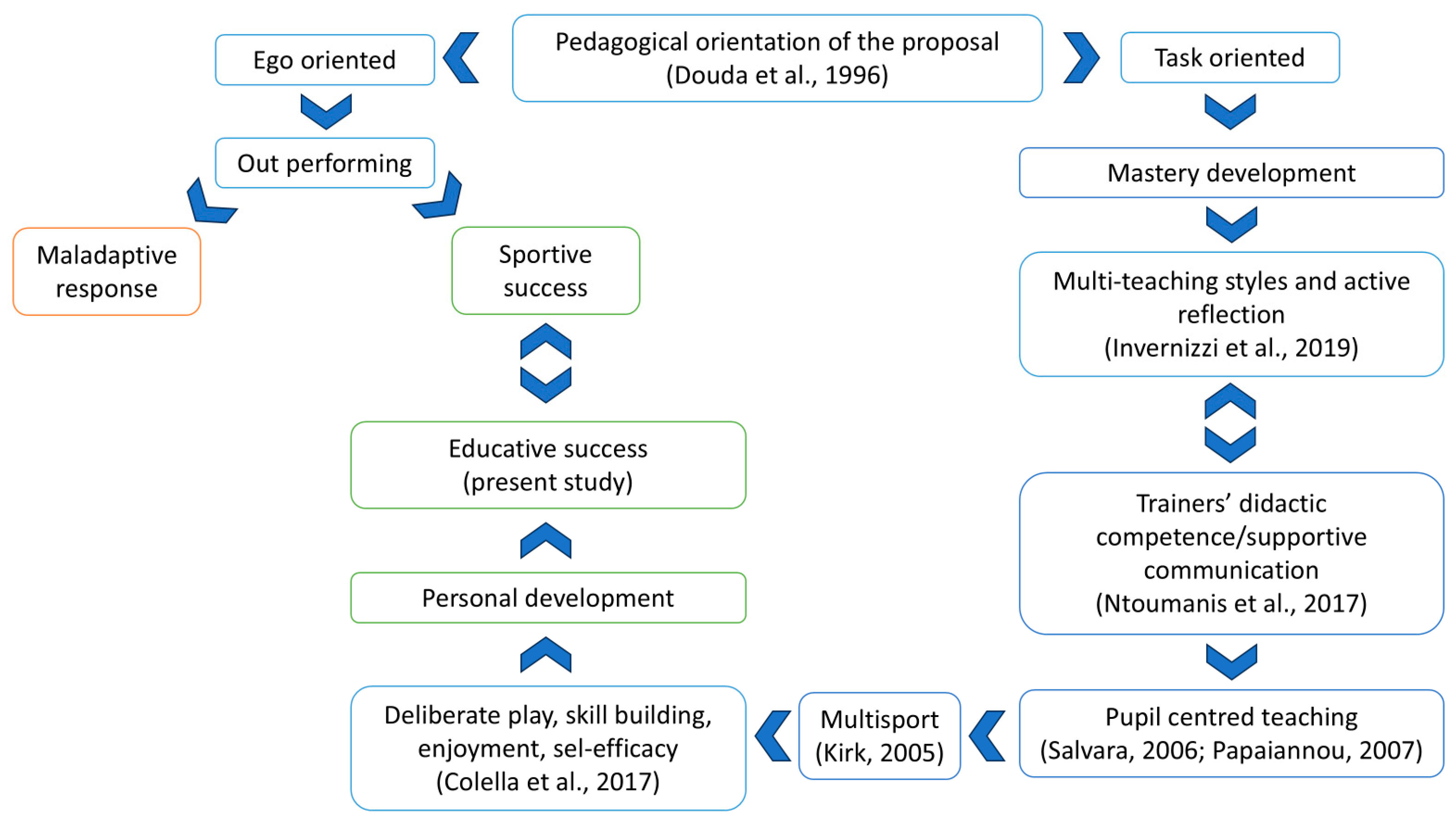

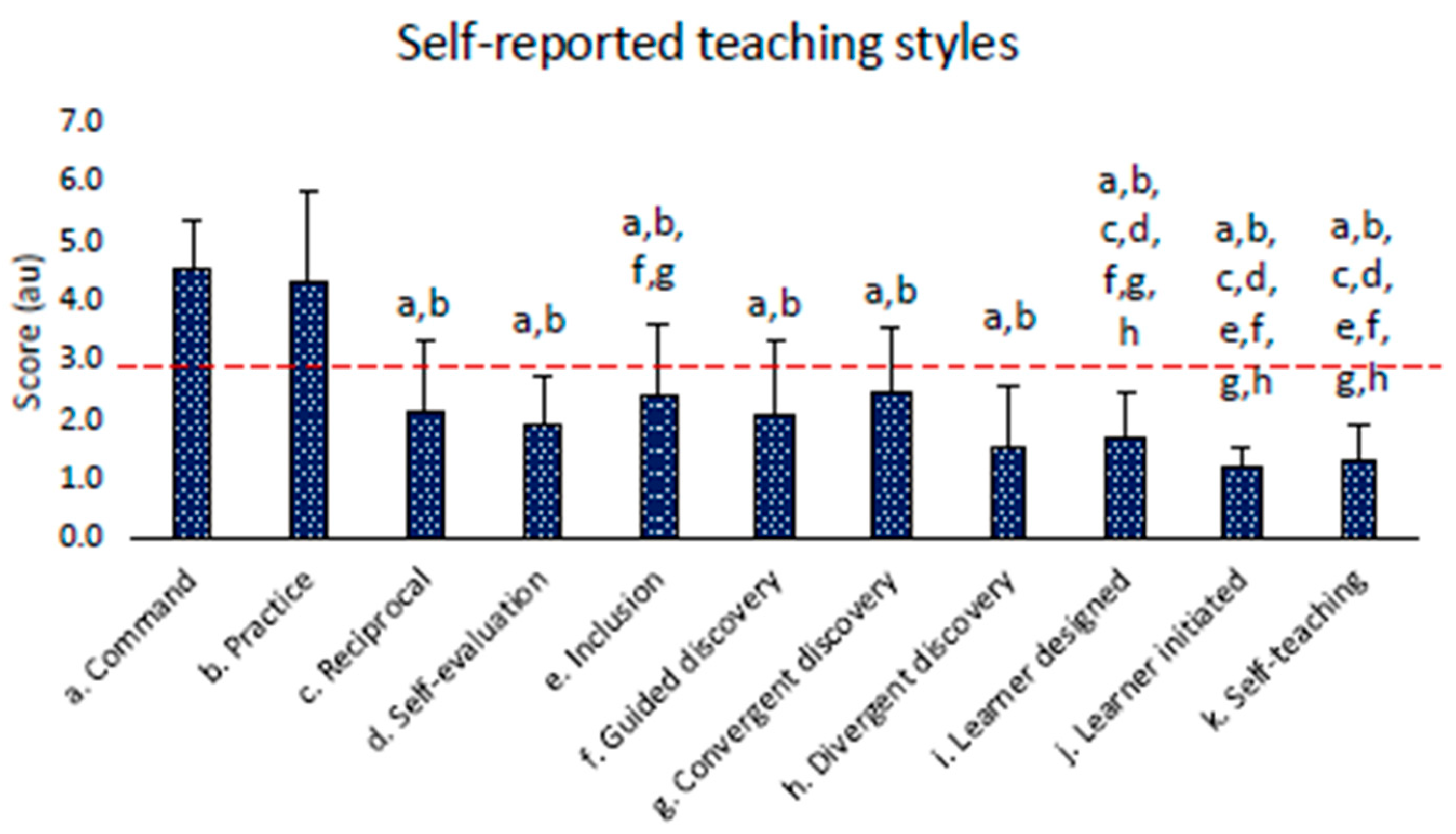
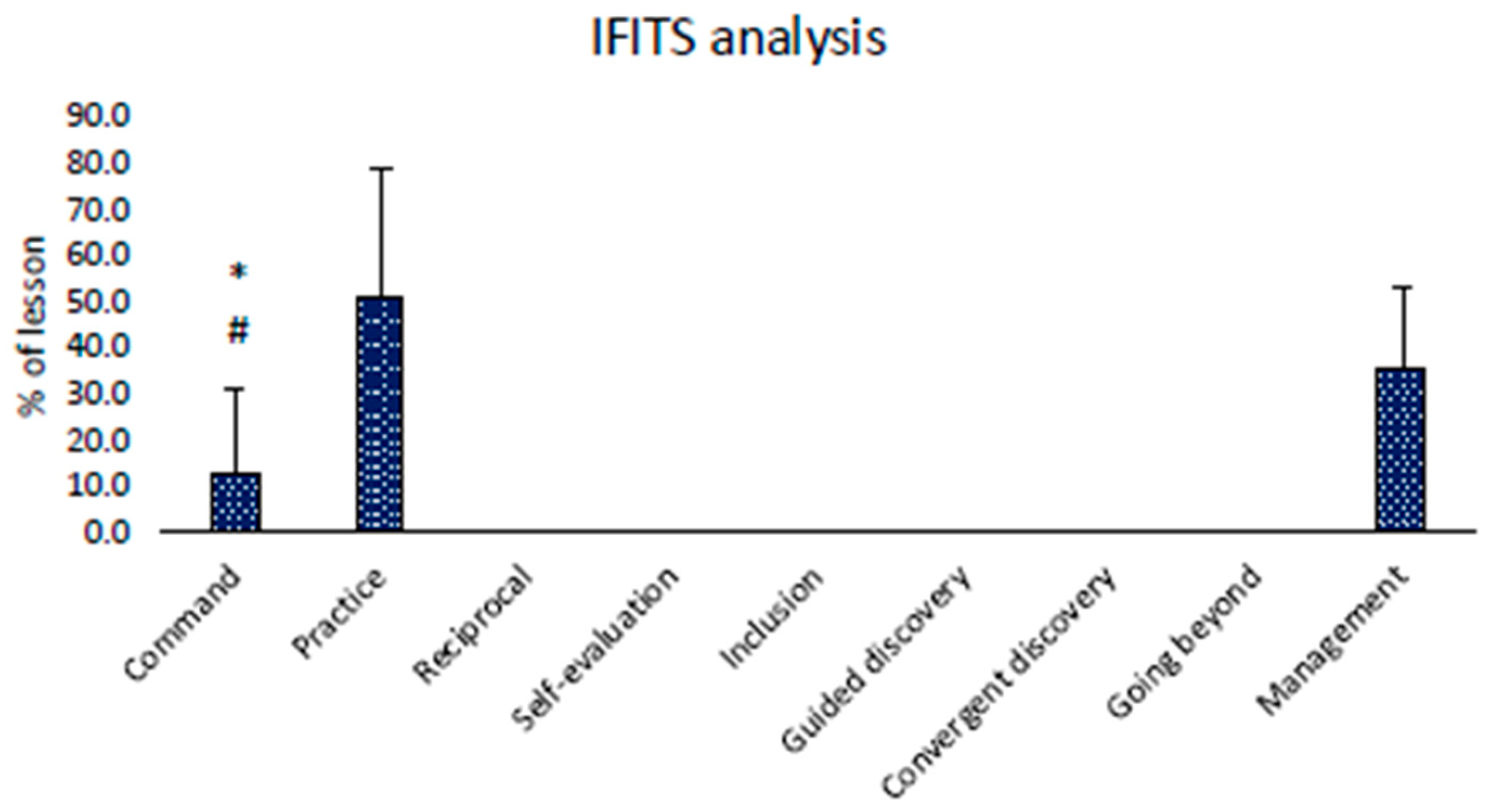
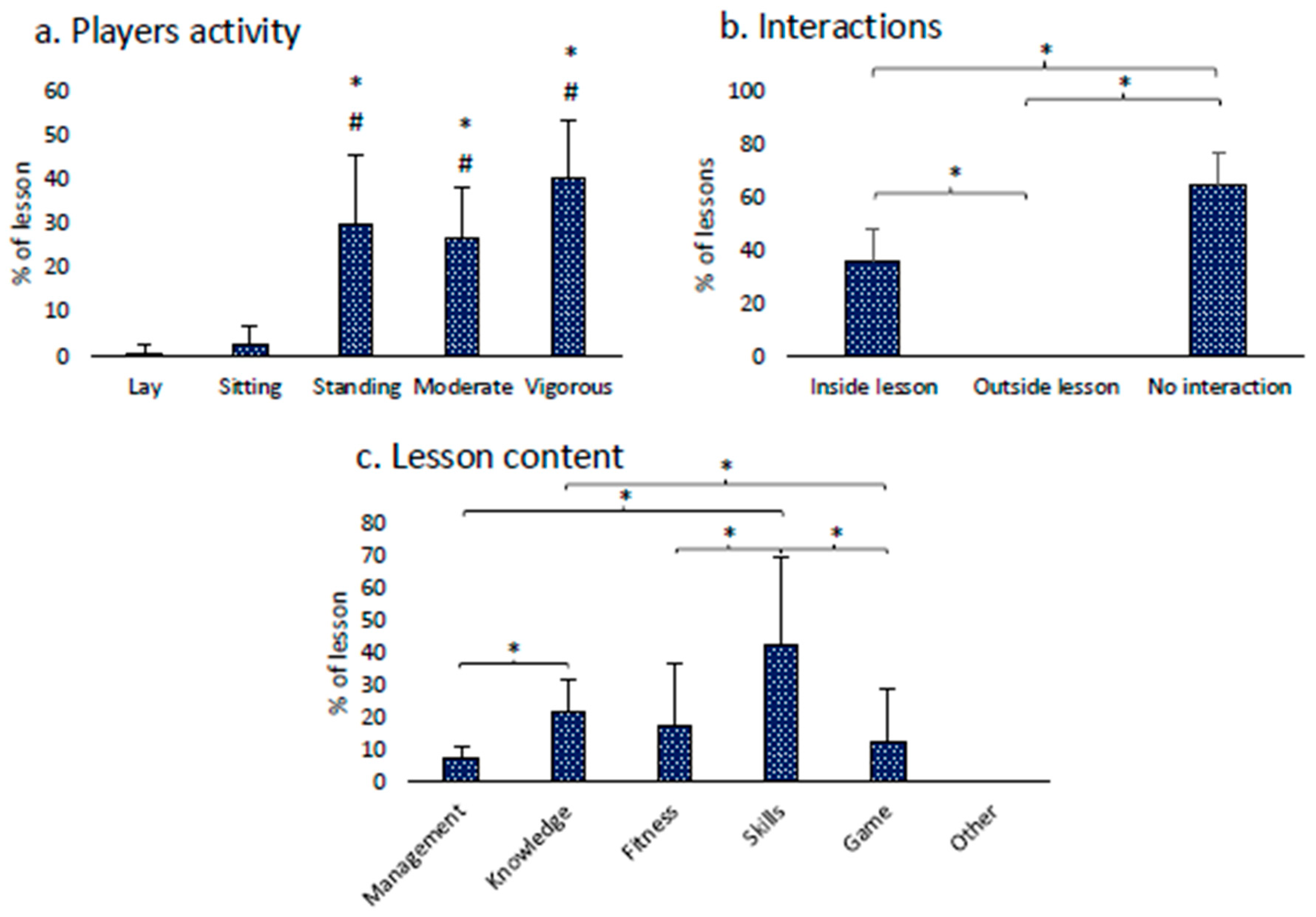
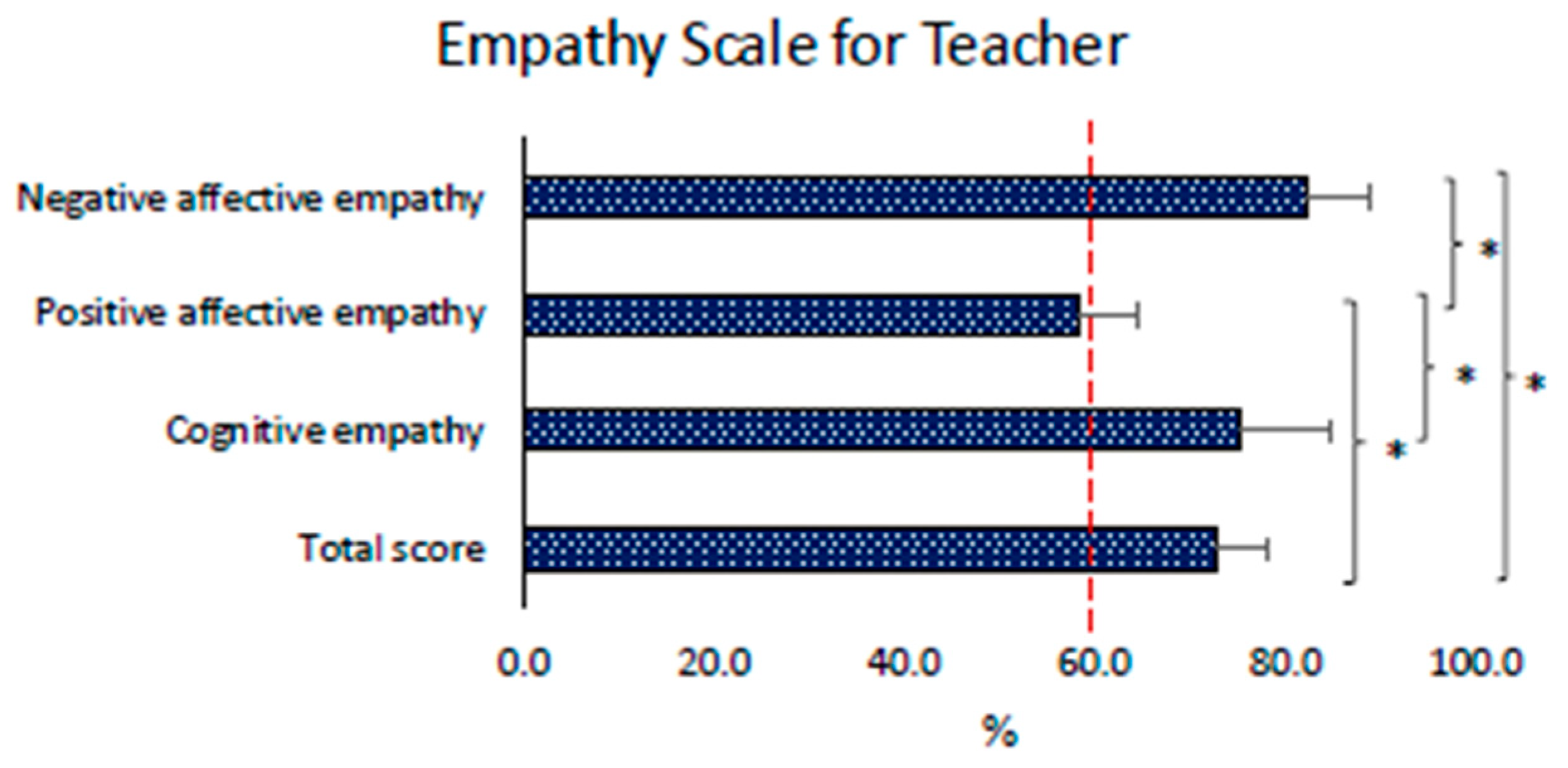
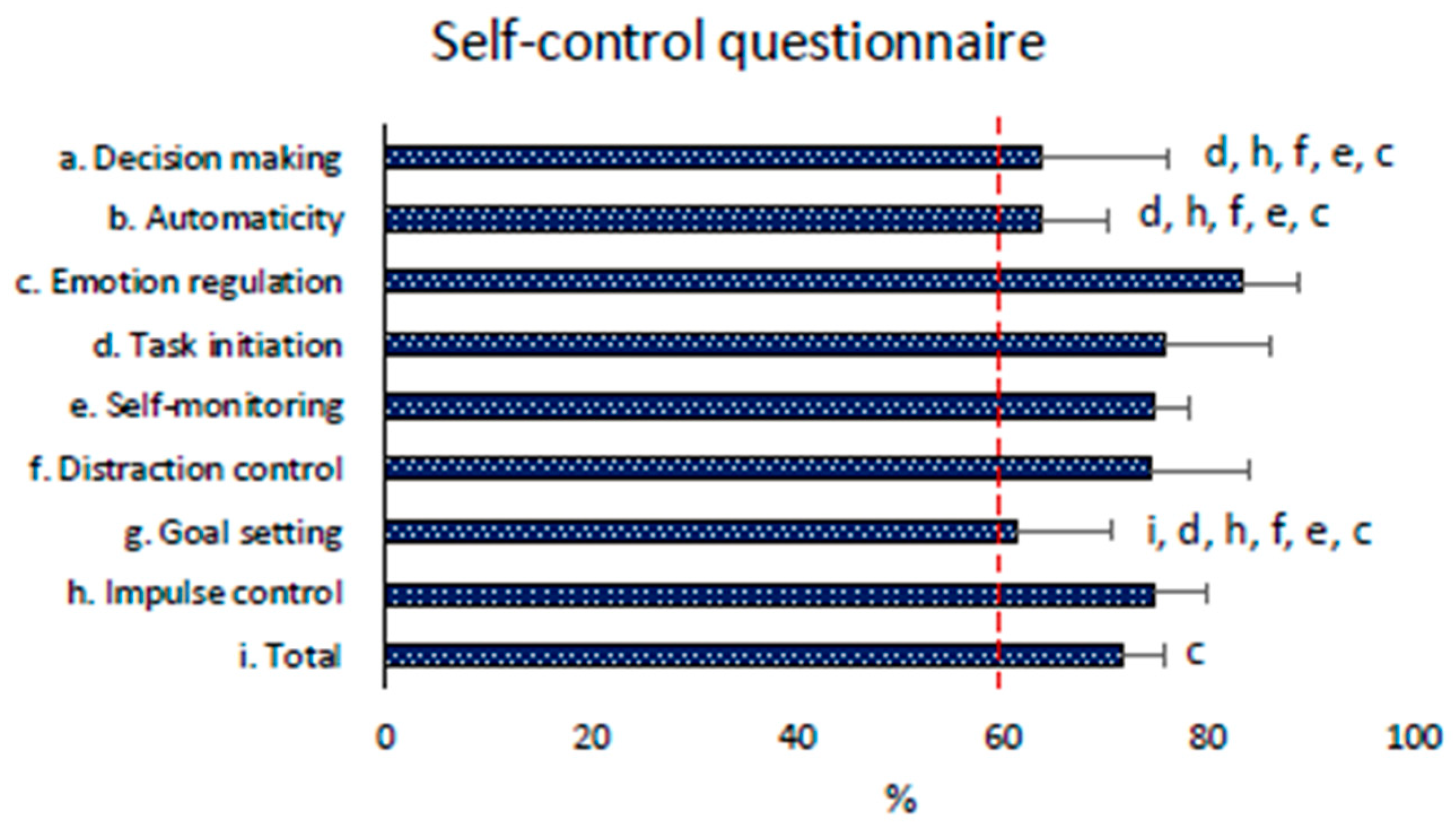
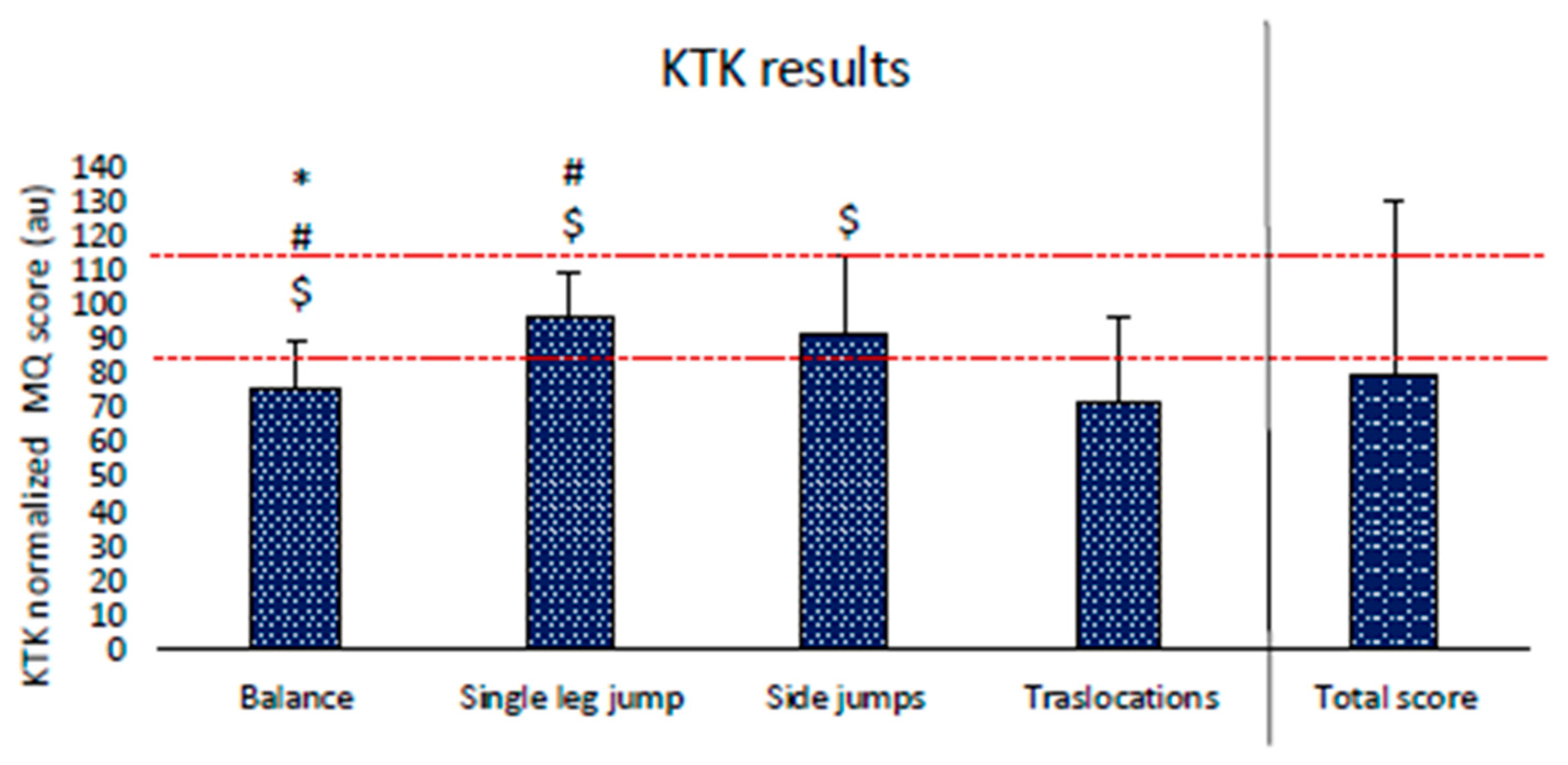


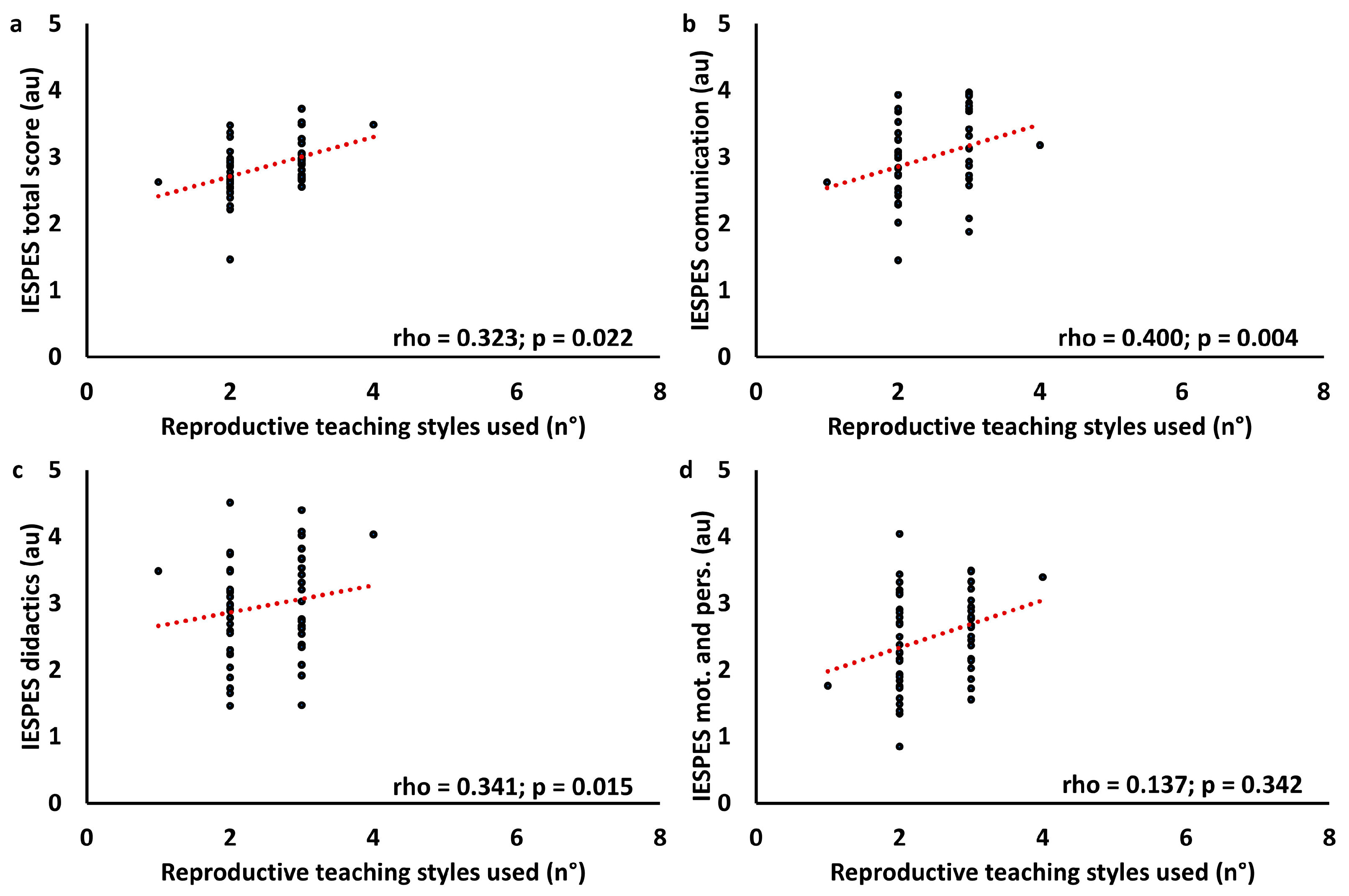

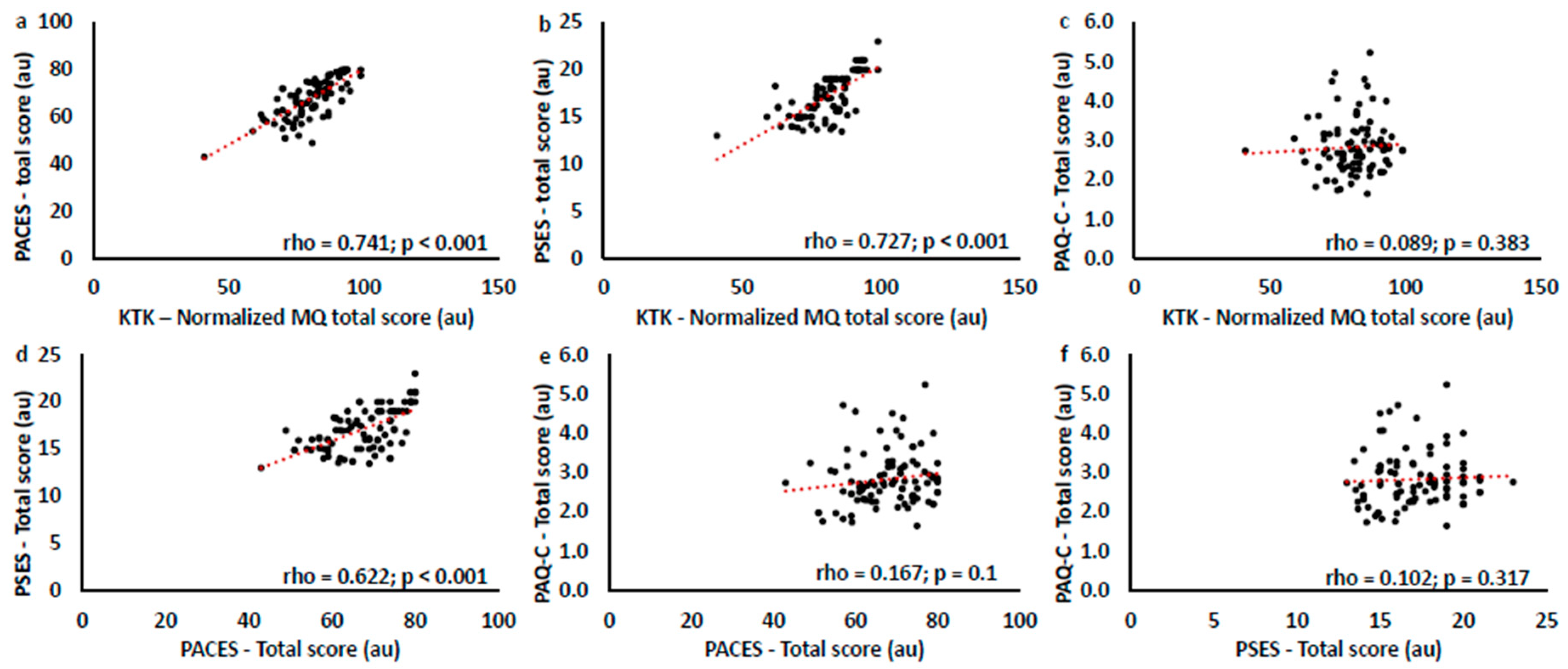
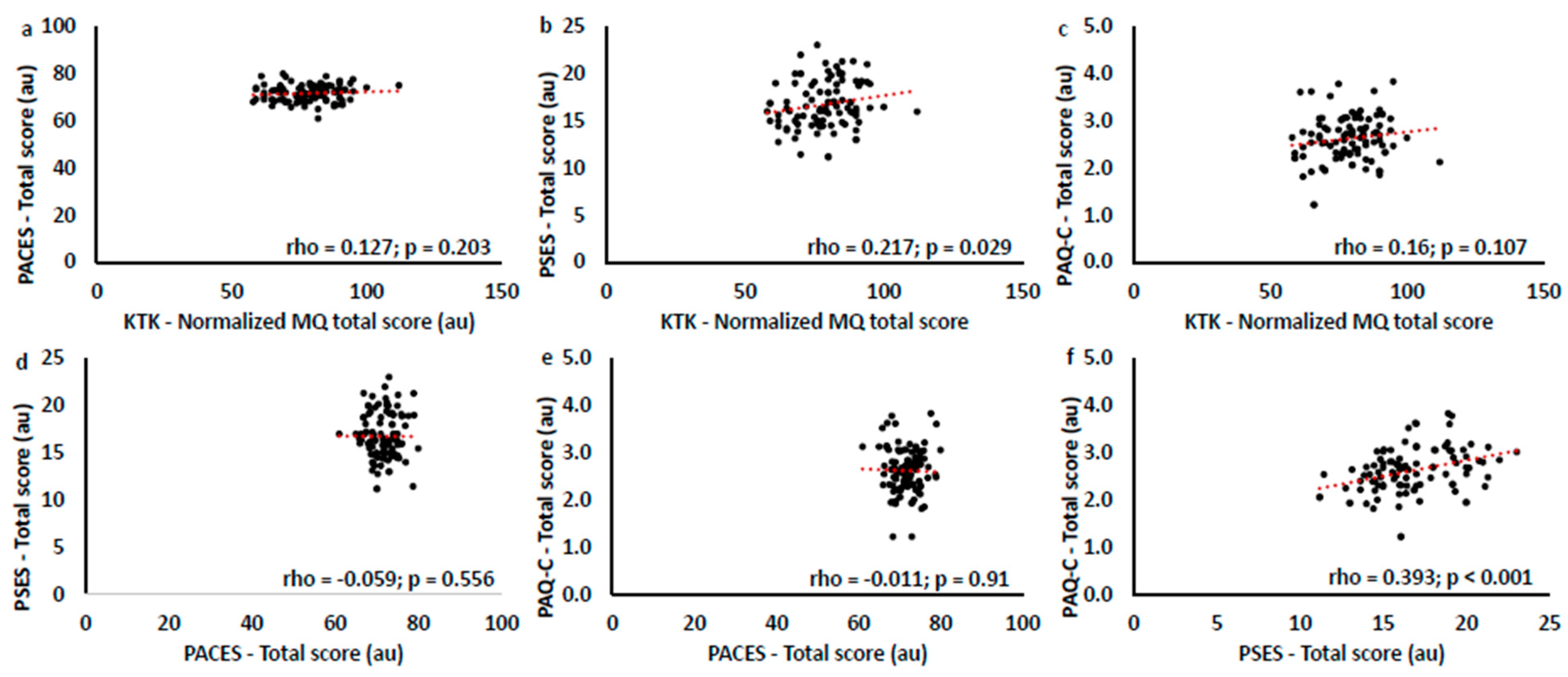
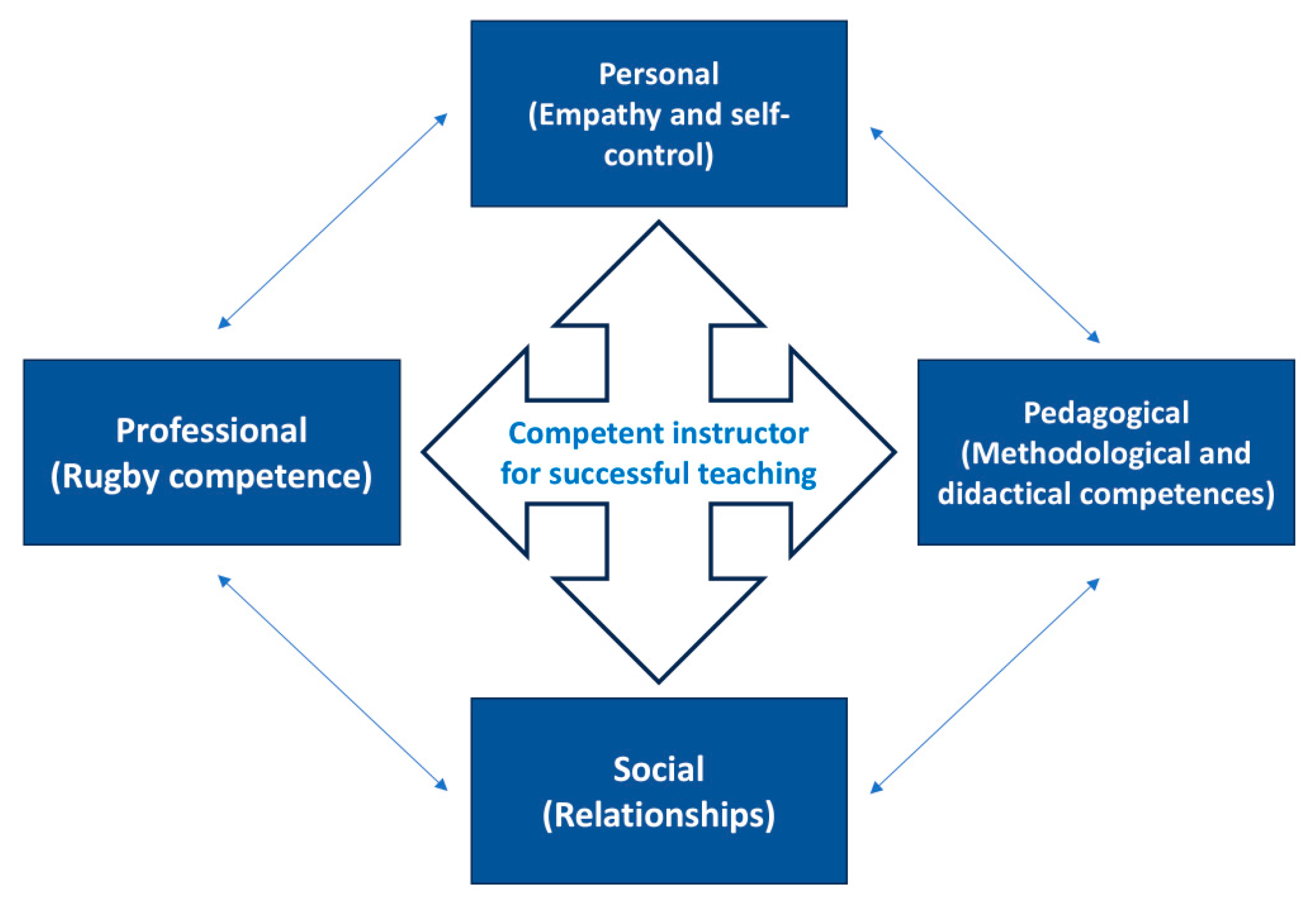
| Children | Instructors | |
|---|---|---|
| Sample size (n°) | 220 | 50 |
| Age (years) | 9.6 ± 1.1 | 39.0 ± 13.6 |
| Males (n°) | 216 | 45 |
| Females (n°) | 4 | 5 |
| Weight (Kg) | 36.0 ± 7.5 | |
| Height (m) | 1.4 ± 0.1 | |
| BMI (kg/m−2) | 18.6 ± 3.3 | |
| Rugby teaching experience (years) | 6.0 ± 5.7 |
| Items | Descriptors 1 |
|---|---|
| Verbal communication | Comprehension; logic; choice of words of appreciation; choice of words of reproach; use of metaphors/narration. |
| Voice and paralanguage | Volume; timbre; modulation; expository rhythm; use of silences and pauses. |
| Non-verbal communication | Facial expression; eye gaze; eye contact; posture; proxemics gestures. |
| Specific didactics | Choice of exercises; progression; demonstration; correction; adaptation of the proposal. |
| Elements of organizational references | Location of tools; location in space of learners; safety/prevention/assistance rules; use of conceptual diagrams/charts/illustrations; time management (activity times; question times; organizational times). |
| Psychological references | Interest aroused; emulation level; expectations/requests; reinforcement; contextualization. |
| Personal competence | Charisma; accuracy; confidence; empathy; self-monitoring |
| Total Scores a | Maximal Reachable Points | % of Maximal Reachable Point a | |
|---|---|---|---|
| PACES (au) | 69.8 ± 6.6 | 80 | 87.3 ± 8.2 |
| PSES (au) | 17.0 ± 2.4 | 24 | 70.6 ± 9.9 |
| PAQ-C (au) | 2.7 ± 0.6 | 5 | 54.6 ± 12.0 |
| Multi-Teaching | Reproduction | Production | Communication | Didactics | MPC 1 | Total Score | ||
|---|---|---|---|---|---|---|---|---|
| Multi-teaching | rho | 1 | −0.136 | 0.195 | 0.661 ** | 0.486 ** | 0.344 * | 0.323 * |
| p-value | - | 0.346 | 0.174 | <0.001 | <0.001 | 0.014 | 0.022 | |
| Reproduction | rho | - | 1 | −0.072 | 0.400 ** | 0.341 * | 0.137 | 0.335 * |
| p-value | - | - | 0.618 | 0.004 | 0.015 | 0.342 | 0.017 | |
| Production | rho | - | - | 1 | 0.564 ** | 0.420 ** | 0.283 * | 0.293 * |
| p-value | - | - | - | <0.001 | 0.002 | 0.046 | 0.039 | |
| Communication | rho | - | - | - | 1 | 0.747 ** | 0.479 ** | 0.542 ** |
| p-value | - | - | - | - | <0.001 | <0.001 | <0.001 | |
| Didactics | rho | - | - | - | - | 1 | 0.538 ** | 0.792 ** |
| p-value | - | - | - | - | - | <0.001 | <0.001 | |
| MPC 1 | rho | - | - | - | - | - | 1 | −0.04 |
| p-value | - | - | - | - | - | - | 0.782 | |
| Total score | rho | - | - | - | - | - | - | 1 |
| p-value | - | - | - | - | - | - | - |
| Children with Multi-Teaching Trainers | Normalized Total MQ | PACES | PSES | PAQ-C | |
|---|---|---|---|---|---|
| Normalized total MQ | rho | 1 | 0.741 ** | 0.727 ** | 0.089 |
| p-value | - | <0.001 | <0.001 | 0.383 | |
| PACES | rho | - | 1 | 0.622 ** | 0.167 |
| p-value | - | - | <0.001 | 0.1 | |
| PSES | rho | - | - | 1 | 0.102 |
| p-value | - | - | - | 0.317 | |
| PAQ-C | rho | - | - | - | 1 |
| p-value | - | - | - | - | |
| Children with Non–Multi-Teaching Trainers | Normalized Total MQ | PACES | PSES | PAQ-C | |
|---|---|---|---|---|---|
| Normalized total MQ | rho | 1 | 0.127 | 0.217 * | 0.16 |
| p-value | - | 0.203 | 0.029 | 0.107 | |
| PACES | rho | - | 1 | −0.059 | −0.011 |
| p-value | - | - | 0.556 | 0.91 | |
| PSES | rho | - | - | 1 | 0.393 ** |
| p-value | - | - | - | <0.001 | |
| PAQ-C | rho | - | - | - | 1 |
| p-value | - | - | - | - | |
| (a) | Empathy | ||||||||||||
|---|---|---|---|---|---|---|---|---|---|---|---|---|---|
| Enjoyment | Total % | Cognitive Empathy % | Positive Affective Empathy % | Negative Affective Empathy % | |||||||||
| Enjoyment | 1 | 0.281 ** | 0.135 | 0.726 ** | 0.019 | ||||||||
| (b) | Self-Control | ||||||||||||
| Total | IC | GS | DC | SM | TI | ER | AU | DM | |||||
| Enjoyment | 0.158 * | −0.202 ** | 0.296 ** | 0.098 | 0.322 ** | −0.298 ** | 0.105 | −0.255 ** | 0.158 * | ||||
| (a) | Empathy | ||||||||||||
|---|---|---|---|---|---|---|---|---|---|---|---|---|---|
| Enjoyment | Total % | Cognitive Empathy % | Positive Affective Empathy % | Negative Affective Empathy % | |||||||||
| Self-efficacy | 1 | 0.397 ** | 0.288 ** | 0.288 ** | 0.223 ** | ||||||||
| (b) | Self-Control | ||||||||||||
| Total | IC | GS | DC | SM | TI | ER | AU | DM | |||||
| Self-efficacy | −0.107 | −0.013 | −0.325 ** | −0.031 | 0.296 ** | 0.035 | −0.092 | 0.092 | −0.324 ** | ||||
Disclaimer/Publisher’s Note: The statements, opinions and data contained in all publications are solely those of the individual author(s) and contributor(s) and not of MDPI and/or the editor(s). MDPI and/or the editor(s) disclaim responsibility for any injury to people or property resulting from any ideas, methods, instructions or products referred to in the content. |
© 2024 by the authors. Licensee MDPI, Basel, Switzerland. This article is an open access article distributed under the terms and conditions of the Creative Commons Attribution (CC BY) license (https://creativecommons.org/licenses/by/4.0/).
Share and Cite
Rigon, M.; Signorini, G.; Scurati, R.; Trecroci, A.; Colella, D.; Formenti, D.; Merati, G.; Cherubini, D.; Invernizzi, P.L. Relationship Between Multi-Teaching Styles and Didactics Effectiveness on Rugby Instructors and Minirugby Players. Children 2024, 11, 1319. https://doi.org/10.3390/children11111319
Rigon M, Signorini G, Scurati R, Trecroci A, Colella D, Formenti D, Merati G, Cherubini D, Invernizzi PL. Relationship Between Multi-Teaching Styles and Didactics Effectiveness on Rugby Instructors and Minirugby Players. Children. 2024; 11(11):1319. https://doi.org/10.3390/children11111319
Chicago/Turabian StyleRigon, Marta, Gabriele Signorini, Raffaele Scurati, Athos Trecroci, Dario Colella, Damiano Formenti, Giampiero Merati, Domenico Cherubini, and Pietro Luigi Invernizzi. 2024. "Relationship Between Multi-Teaching Styles and Didactics Effectiveness on Rugby Instructors and Minirugby Players" Children 11, no. 11: 1319. https://doi.org/10.3390/children11111319
APA StyleRigon, M., Signorini, G., Scurati, R., Trecroci, A., Colella, D., Formenti, D., Merati, G., Cherubini, D., & Invernizzi, P. L. (2024). Relationship Between Multi-Teaching Styles and Didactics Effectiveness on Rugby Instructors and Minirugby Players. Children, 11(11), 1319. https://doi.org/10.3390/children11111319











